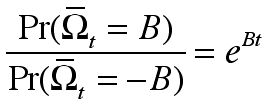Denis Evans' Professional
Page.
This page includes information which is additional to my
official Research School of Chemistry Home Page entry
and
to my hiking/bushwalking pages at: http://ehrenfest.anu.edu.au/~denis/index.php
and
https://plus.google.com/+DenisEvans/posts

Snowgums above Dead Horse Gap (June, 2001).
-
Statistical Mechanics
We are known for deriving
and experimentally confirming the Fluctuation Theorem.
This Theorem gives an elegant
extension of the Second Law of Thermodynamics,
so that it applies to finite
systems observed for finite times. It also provides the first proof of the Second Law of Thermodynamics - it ceases to be a "Law".

This theorem relates the probabilities of observing time averaged values of a generalized entropy production, namely the dissipation function,

for a period of time, t, equal to an arbitrary value B, relative to -B. This ratio is exponential in the length of the averaging time t, and the number of degrees of freedom in the system - since entropy production is extensive. In the definition of the dissipation function f(G,0) is the initial phase space distribution function dQ/dt is the rate of heat gained or lost per unit time by the system of interest from a thermostat. The thermostat is viewed as being much larger than the system of interest and can therefore be regarded as being in thermodynamic eqilibrium at a temperature Tres.
The Theorem resolves the
paradox of how time-reversible microscopic dynamics leads, to irreversible
macroscopic behaviour. It also implies that as devices are made smaller
and smaller the probability that they will run thermodynamically in reverse
to what one would expect, increases exponentially with decreasing system
size and observation time.
This result is exact for classical systems and quantum anologues are known.
Scientific news articles, popular press
and news reports on the Fluctuation
Theorem, October 2002.
See also C. Bustamante, J. Liphardt, and F.
Ritort, Physics Today, 58,
no 7, page 43-48, 2005.
The Second Law Inequality is a simple consequence of the Fluctuation Theorem.

It says that the generalized entropy production can be negative but the time average of the ensemble average cannot be negative.
(Searles and Evans, Aust. J. Chem., 57,1119(2004).)
The Dissipation Theorem says that the nonlinear response of an arbitrary phase variable can be calculated from the time integral of the nonequilibrium transient time correlation function of the phase variable with the dissipation function
(Evans, Searles &Williams, J.Chem.Phys., 128, 014504(2008), ibid 128, 249901(2008).):

Finally the Relaxation Theorem says that if an arbitrary initial ensemble of ergodic Hamiltonian systems is in contact with a heat bath and there is a decay of temporal correlations, then the system will at long times, relax to the Maxwell-Boltzmann distribution. Further, this distribution has zero dissipation everywhere in phase space. For such systems no other distribution has zero dissipation everywhere.

Each of these results is exact arbitrarily far from equilibrium and independent of system size.
-
Liquid State Chemical Physics Research Group
Group members include
Dr Stephen Williams.
Here are two group photos (2001).
In the first photo we have from left to
right, Owen Jepps (former student), Dr Jerome Delhommelle , Emil Mittag (former
student) and
Dr Janka
Petravic.
In
the second
photo we have Emil, Jerome, Denis and Janka.
The group in 2005. Left to right: James Reid, Stephen Williams and Denis.
We have longstanding and close links with Dr
Debra Searles, Griffith University
Queensland, and Dr Edie
Sevick in the Research School of Chemistry ANU.
-
- My Thomson H-index is 55. My Scholar Google H-index is 62 (8/6/1014).
My Scholar Google web site is here. This Scholar Google site has been vetted by me as accurate and contains much information including the publications as well as various citation data.
CV, lecture notes and publications
-
- List of Publications, Curriculum
Vitae, Annual
Report, Liquid State
Chemical Physics Group , Official home page.
- Denis Evans' Boltzmann number is 4: Boltzmann 0; Ehrenfest (student) 1; Uhlenbeck (student) 2; Cohen (mentor) 3; Evans (mentor) 4.
- Denis Evans' Einstein number is 4,
but there is another publication route giving an Einstein Number of 6-
but this route involves some really great scientists.
-
Papers and lectures on the NonEquilibrium Statistical Mechanics
- Lecture Notes (215Kb) on "Nonequilibrium
Statistical Mechanics and Lyapunov Instability" (In Adobe Acrobat format.
Obtain the reader free from Adobe).
- Lecture Notes (332Kb) on "Nonlinear
Response Theory of Non-Autonomous Systems" (Acrobat format).
- Lecture 1 (65Kb), Lecture
2 (65Kb) and Lecture 3 (98Kb), on "NonEquilibrium
Statistical Mechanics and Lyapunov Instability" by myself and Debra Searles
(Acrobat format).
- Paper on "Approach to the nonequilibrium
time-periodic state in a steady shear flow model" , Mol. Phys., 95,
219-231 (1998). .
- Paper on "Configurational Temperature,
Verification of Monte Carlo Simulations" J. Chem. Phys., 109, 6519-6522(1998)
J. Chem.
- Phys.2000/2001 Boys-Rahman lecture
of the Royal Society
of Chemistry (London).
- A paper on the entropy of nonequilibrium
steady states, with Lamberto Rondoni,
J. Stat. Phys, 109, 895-920, (2002).
- New observations concerning time
reversible deterministic thermostats - why the standard forms for deterministic
thermostats are unique - J. Chem. Phys., 133, 104106-4(2010)
- Real
audio,
and Lecture
II on Fluctuation Theorems with (24MB) Real
audio. These lectures can be downloaded as podcasts from the Apple
iTunes store.
- Lectures (video) at the 2006 Durham International Conference on "Dynamical
Systems and Statistical Mechanics" by Debra Searles, Lamberto Rondoni and
myself are searchable on Apple iTunes search for Denis Evans or Fluctuation
Theorem.
- A (video) lecture on the Fluctuation and Dissipation Theorems, given in the Research School of Information Sciences and Engineering, Canberra Australia, August 2007. The Power Point presentation is here.
- Statistical Mechanics of Time Independent Non-Dissipative Nonequilibrium States - but this does involve the Transient Fluctuation Theorem.
- Two lectures on Chaos and NonEquilibrium statistical mechanics given at the Institut Henri Poincare, October 8, 2006. Lecture 1 and Lecture 2.
- Three lectures at Oak Ridge National Laboratory, April 22, 2008: lectures 1, 2, 3.
- Australian National University, Physics and Chemistry honours year undergraduate lectures on: "The Foundations of Statistical Thermodynamics"
- The rheology of crystals.
Papers on the Fluctuation Theorem and related topics - Scientific
news articles and popular press reports on
the Fluctuation Theorem, October 2002.
- The first paper on any Fluctuation Theorem: ECM2,
Evans, Cohen & Morriss,
Phys. Rev. Letts., 71,
2401(1993).
- Paper “A local fluctuation
theorem”, J. Chem. Phys., 115 , 2033–2037 (2001),
http://xxx.lanl.gov eprint archive cond-mat/9901256.
- Paper on "The Fluctuation Theorem for
Stochastic Systems", Phys Rev EZ6305, (1999), http://xxx.lanl.gov eprint
archive cond-mat/9901258.
- Paper on "The Fluctuation Theorem and
Green-Kubo Relations", J Chem Phys, 112,9727(2000), by
Debra Searles and myself http://xxx.lanl.gov/abs/cond-mat/9902021.
- Draft paper on the Fluctuation Theorem
for heat flow.
- Review : "The Fluctuation
Theorem" by Denis J Evans and Debra J Searles, Advances in Physics, 51,
1529-1585(2002).
- Experimental test of the Integrated Fluctuation
Theorem using optical tweezers, Phys. Rev. Lett. 89,
050601 (2002). An animation of
the experiment.
- A rigorous derivation
of the Transient Fluctuation Theorem using Lyapunov rather than Gibbs,
weights, Physica D, 187, 326-337(2002).
- A paper by Denis J. Evans, on NonEquilibrium
Free Energy Theorems, Molecular Physics, 101, 1551(2003).
- A Fluctuation Theorem for time dependent
dissipative fields, Phys. Rev. E 67, 026113 (2003) .
- A talk Thermodynamic
limits to nanomachines Australian
Academy of Science International Symposium on:
Nanoscience – where physics, chemistry and biology collide, Canberra,
2 May 2003.
- Download a talk on
the Fluctuation Theorem by Debra Searles.
- Preprint of a proof that the Gallavotti
Cohen FT converges ever more slowly as equilibrium is approached, archived at http://xxx.lanl.gov/pdf/cond-mat/0312353,
and Phys. Rev. E 71, 056120 (2005).
- First experimental confirmation of the
(detailed) Transient Fluctuation Theorem, Phys. Rev. Lett., 92,
140601(2004).
- Explicit demonstration of the independence
of the Fluctuation Theorem to details of thermostatting mechanism, Phys.
Rev. E 70, 066113 (2004).
- Demonstration that van Zon and Cohen FT
is an example of the Gallavotti-Cohen FT, to appear Molecular Simulation.
- First experimental confirmation of the steady state FT by observing the
response of an electrical circuit to thermal noise. Nonequilibrium fluctuations
in a resistor by: Nicolas Garnier, Sergio Ciliberto: http://xxx.lanl.gov/abs/cond-mat/?0407574 .
- Experimental confirmation of the steady
state FT for a colloidal particle in an optical trap ( Physical
Review E).
- Mathematical derivation of the Steady State Evans Searles FT from the Transient Fluctuation Theorem - J. Stat. Phys.
- Direct verification that time-reversibility is a necessary condition for the Evans Searles Fluctuation Theorem - Pure and Applied Chemistry, Procedings of the 19th IUPAC Conference on Chemical Thermodynamics 2006.
- Deterministic derivation of the Second Law Inequality from the Jarzynski Relation - C.R. Physique (2007).
- First experimental confirmation of fluctuation theorems for viscoelastic media (where the white noise Langevin equation fails) - J. Opt. A: Pure Appl. Opt., 9 2007.
- Studies of certain conjectures regarding far from equilibrium steady state flucuation theorems - when the number of positive and negative Lyapunov exponents become unequal.
- On Irreversibility, Dissipation and Response Theory.
- The Relaxation Theorem
- A simple mathematical proof of Boltzmann's equal a priori probability hypothesis
Papers on glasses and related topics
- Statistical Mechanics of Time Independent Non-Dissipative Nonequilibrium States
- The Glass Transition and the Jarzynski Equality
Dissipation and the Foundations of Statistical Thermodynamics
-
- by Denis J. Evans, Debra J. Searles and Stephen R. Williams
- Select chapters: Title page, Table of Contents, Symbol list, Chapter 1, Chapter 2, Chapter 3, Chapter 4, Chapter 5, Chapter 6, Chapter 7, Chapter 8, Chapter 9
-
-
Statistical Mechanics of NonEquilibrium Liquids
by Denis J. Evans and Gary P. Morriss
The second edition of my book with Gary Morriss was published in 2008.
Publisher: Cambridge University Press; 2 edition
ISBN-10: 0521857910
ISBN-13: 978-0521857918
The first edition was published by Academic Press, London 1990, Theoretical Chemistry Monograph
Series.
The first edition is no longer available from Academic Press. We therefore provide
this web version of the book here. The first edition is also available at the Australian National University ePress. The ePress version is available electronically or in a softbound copy for a small fee.
These files are available for personal use only. No bulk
reproduction or resale is permitted. The first edition is Copyright © 1990 Denis J.
Evans and Gary P. Morriss.
A major review which includes a treatment of molecular fluids is given in:
Sarman S., Evans D.J. and Cummings P.T., "Recent developments in non-Newtonian
molecular dynamics", Physics Reports, Elsevier (Ed. M.J. Klein), 305(1-2) 1-92
(1998).

Australia hosted Statphys 24, in Cairns Queensland, July 19-23, 2010.
http://www.statphys.org.au/
Links. for students, postdocs and visitors
to Canberra.
-
-

If you have comments or suggestions, email me at evans@rsc.anu.edu.au
[RSC WWW Server
| Research School of
Chemistry| Department
of Chemistry]








